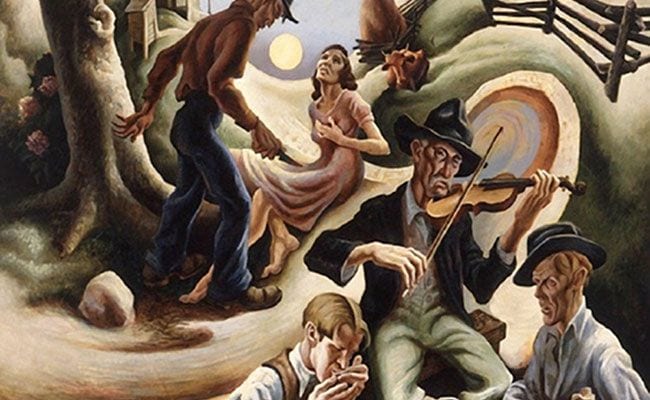
Stagolee, Frankie and Johnny, Tom Dooley, and John Henry are all familiar names to those well-versed in folk music and its’ accompanying traditions. Popular, too, are events like the Wreck of the Old 97, the trial of Sacco and Vanzetti, and of course the sinking of the Titanic. Less well known, though, are the tragic stories of poor murdered souls like Ellen Smith and Pearl Bryan, the anonymous faces of prisoner chain gangs, and the tortured existences of those forced to toil away in coal mines buried deep below the majestic Appalachian mountains.
In one manner or another, all of these tales have stood the test of time and have been immortalized in the American Folk Song Canon. In Hear My Sad Story, Richard Polenberg, emeritus professor of history at Cornell University, takes on the audacious task of documenting the various true (though sometimes tall) tales that comprise the subject matter of many well-known and long-lasting folk songs.
It’s a noble attempt by the author to provide background and meticulously researched detail on the events that inspired these tunes. After all, while a good number of people can identify a Pete Seeger, Woody Guthrie, or Blind Willie McTell ditty, fewer can actually serve as knowledgeable interpreters of the tunes’ lyrical references. With this book, Polenberg offers forth an entertaining and insightful account of the actual events, however murky they may be, that have stood the passage of time to become a part of the American historical legend.
Like the book’s title implies, the stories and events recounted are in fact, sad. Poor young women like Omie Wise and Delia Green are callously murdered by jealous and immature lovers. Children, some as young as seven years old, were forced into North Carolina cotton mills where they were subjected to brutally dangerous working conditions with little pay and no benefits offered in return.
Times were also extremely dangerous. As outlined in the section entitled, Bold Highwaymen and Outlaws, bandits like Jesse James brazenly roamed the land while police authorities and shadow organizations like the Pinkerton Gang ruthlessly mowed down whatever stood in their way.
Travel was frequently necessary, but extremely dangerous. A shocking statistic unearthed in a chapter on railroad conductor Casey Jones revealed that 78,152 people perished in rail accidents spanning the decade-long period of 1895 to 1905.
With so much turmoil in the air, it’s little wonder that tunesmiths and folklorists began writing and singing of these calamitous events.
Polenberg’s book follows a set format with chapters divided amongst themes that document murder, crime, disaster, and martyrs. Each section contains several individual chapters that contain news-like reporting of specific events, characters, and situations followed by the various forms in which these circumstances made their way into well-known songs. Because of this format, readers can easily flow from one section or chapter to the next with little regard for order or continuity. In fact, the book actually may be best enjoyed this way; reading a couple of cold-blooded murder stories in a row tends to become a bit taxing as the details and environments start to blend together.
While the book is a treasure trove of historical information and anecdotes, it reads a bit too much like a history textbook at certain points. Polenberg’s historian side tends to win out, with recitation dominating over a more in-depth look at the musicology these events brought forth. Also, while brief mention is made of Bob Dylan, Nina Simone, and Johnny Cash, nothing is said of the contemporary artists who have made music inspired by these tales. Neko Case, The Sadies, The Handsome Family, and Nick Cave are just a few examples of musicians who have recorded stellar interpretations of these folk standards, not to mention bands like Old 97s that took their name from one of the particular events highlighted with these pages. Polenberg often ends his summation of folk tunes with their first known origins rather than tracing them down to a more recent path.
A major takeaway are the details in which Polenberg documents the sheer morbid fascination citizens of the times. Thousands of people turned out to witness public hangings; special excursion trains crossed several state lines to transport onlookers hoping to attend John Hardy’s execution while Morris Slater’s (aka Railroad Bill) embalmed body laid in repose for weeks so as to better accommodate those wishing to gain a firsthand look at the notorious wanted man.
The book also points out the enormous volume of executions that took place in the late 19th and early 20th centuries. Though soon to be commonly replaced by electrocution, hangings were still the preferred method of capital punishment, with vengeful state governors handing down death sentences that would appease their bloodthirsty constituents. Many of the folks facing these sorrowful fates tended to be overwhelmingly poor, African-American, and uneducated. The book is filled with examples of lawless police members and amped-up citizens chasing, terrorizing, maiming, and killing innocent people of color simply because of their perceived associations with the wanted criminal. It was largely a repercussion of the ugly politics of Reconstruction and the blatant foulness of the Jim Crow era that would soon follow.
Well researched and packed with fascinating detail, Hear My Sad Story tells more than just the origins of popular folk songs. It tells an unflinching and honest story of America. At times viciously misguided and undoubtedly ugly, the country’s history has nevertheless been documented through the lenses of those who witnessed these events and passed them down to subsequent generations. Celebrated in song, the tales outlined through the book’s nearly 300 pages seem poised to continue their grip on the fabric of society as we move further away from the actual events. As history continues to unfold, there are surely those amongst us today whose interpretations of modern events will be relied upon by future songwriters to help make sense of life in our time. It’s the American tradition.


![Call for Papers: All Things Reconsidered [MUSIC] May-August 2024](https://www.popmatters.com/wp-content/uploads/2024/04/all-things-reconsidered-call-music-may-2024-720x380.jpg)



